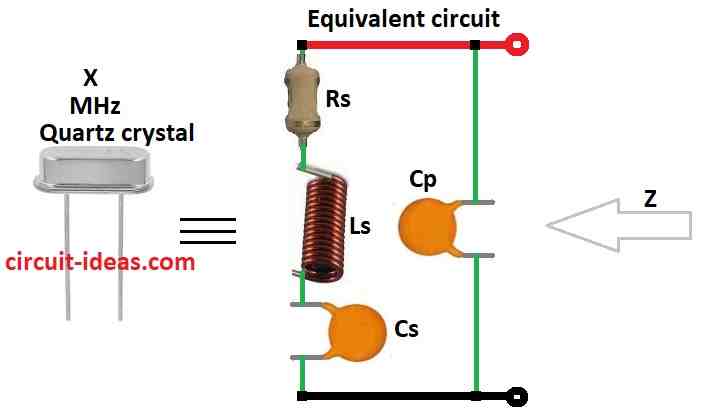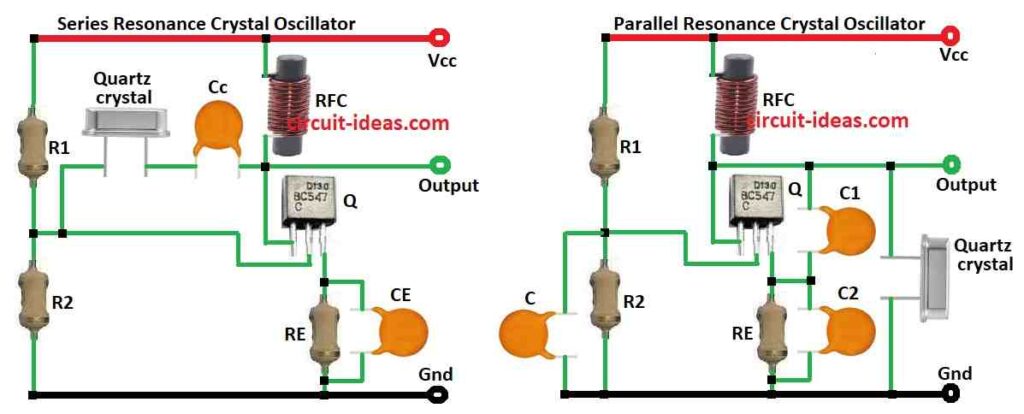To design Design Crystal Oscillator Circuit need know some basic things.
Use crystal to make steady frequency.
Choose right crystal and connect with other parts like resistor and capacitor.
Be sure circuit give right signal for our device.
Easy steps help us build good working circuit.
Circuit Working:

Let us learn about this circuit with help of above diagram:
Crystal Oscillators is like an Heartbeat for Electronics
Crystal oscillator is circuit that uses special mineral called quartz.
Quartz show piezoelectric effect and it vibrate when voltage come and give small voltage when vibrated.
Because of this the quartz crystal makes a very steady signal.
Circuit uses this to give constant frequency.
This frequency does not change much with heat or environment.
Why Important?
Crystal oscillator gives stable timing signal and is very useful in:
Electronic watches, Microcontrollers and microprocessors and Clock circuits
How it works:
Quartz work like transducer and it changes electricity into vibration and back.
Crystal stay between two metal plates and the circuit parts help keep it vibrating.
Inside model of crystal:
Series RLC part show:
Rs as resistance
Ls as inductor means stiffness
Cs as capacitance inside crystal
Parallel Cp as capacitance between metal plates
Designing for right frequency:
There are two main types: Series resonance and Parallel resonance
To get correct frequency we need to choose right external parts like resistors, capacitors.
Formulas:
Series Resonance Formula:
fs = 1 / 2π√(Ls * Cs)
where,
- fs is the resonance frequency in Hz
- Ls is the inductor value in henries H
- Cs is the capacitor value in farads F
What it mean:
Crystal vibrate most at this frequency.
Inductor and capacitor pass energy back and forth.
At this point circuit allow max current and is at very low resistance means impedance and this called resonance.
Angular frequency (speed of phase change):
ωs = 2πfs
How we get formula:
At resonance:
XL = XC → ωLs = 1 / ωCs
Solve for ω convert to fs and fs = 1 / 2π√(Ls * Cs)
Parallel Resonance Formula:
fp = 1 / [2π√(Ls * (Cp * Cs / (Cp + Cs)))]
where,
- fp is the parallel resonance frequency in Hz
- Cp and Cs are the two capacitor values
- Ls is the inductor in H
What happens here:
Inductor and two capacitors cancel each other at one frequency of fp.
This time impedance is very high means opposite of series.
Circuit block current here with less feedback.
Capacitance in parallel circuit:
1 / Ctotal = 1 / Cp + 1 / Cs
Result uses the above formula.
Choosing Right Type:
Series Resonance:
- Stronger signal
- Good for keeping oscillation going
Parallel Resonance:
- High impedance
- Good when need reduce feedback
Both need right Ls, Cs, Cp values to give correct frequency.
Use carefully to design oscillator for clocks, microcontrollers etc.
Crystal Oscillator circuit diagram:

Building Crystal Oscillators: Series vs Parallel Resonance
Crystal oscillator circuit can be made in two main ways.
Each way give different type of resonance.
1. Series Resonance Oscillator:
Use transistor in common emitter mode.
Crystal and coupling capacitor are placed between base and collector.
Base controls current between collector and emitter and works like amplifier.
Output comes from collector.
Crystal gives series resonance here.
2. Parallel Resonance Clock:
Same common emitter transistor used.
But now crystal is between collector and emitter.
Output is also taken from collector.
This setup gives parallel resonance.
Key Point:
- Even with same transistor setup where crystal and capacitors are placed, decides Series or Parallel Resonance type.

Main Parts and Device used in Crystal Oscillators:
Crystal oscillator use one main switching part in center.
This can be:
BJT (bipolar junction transistor), FET (field effect transistor), MOSFET (metal oxide field effect transistor)
These parts amplify signal and help keep the oscillation going.
Working with Microcontrollers and Microprocessors:
Many new microcontrollers and microprocessors have built-in pins for crystal oscillator.
So no need for extra oscillator circuit.
These pins work with specific crystal frequency to keep the IC chip working properly.
Conclusion:
How to Design Crystal Oscillator Circuit uses quartz crystal to give steady and correct signal like metronome in music.
We can build different circuits to get needed frequency.
Very important for accurate timing in small things like watches and big things like computers.
Because they are flexible and can be built-in in microchips, they are must have part in modern electronics
Leave a Reply